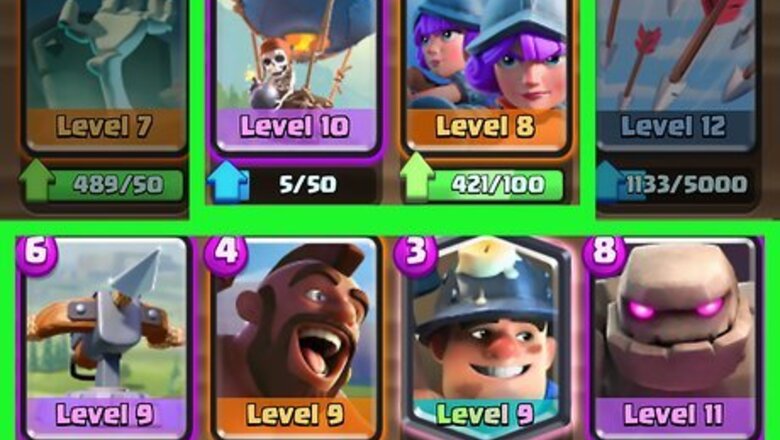
views
Defining Your Deck
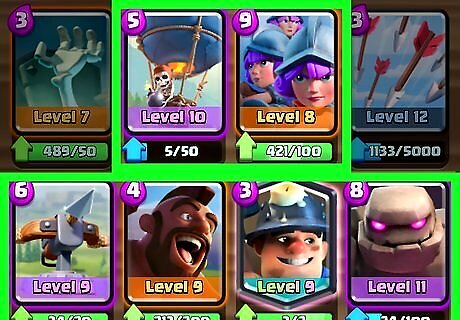
Choose a win condition. Your win condition is the card you pick as your main offensive threat. It should be able to reliably deal damage to your opponent's towers in some way such as by being placed directly on the tower, only targeting buildings, or another way. You will build a deck around this win condition. Whatever card you choose should be at a high enough level to be strong in your current arena. Some win conditions include: Hog Rider, Ram Rider, Electro Giant, Royal Giant, Balloon, X-Bow, Miner, Mortar, Golem, Graveyard, Sparky, Goblin Drill, Lava Hound, and Three Musketeers. There are many more possible win conditions.
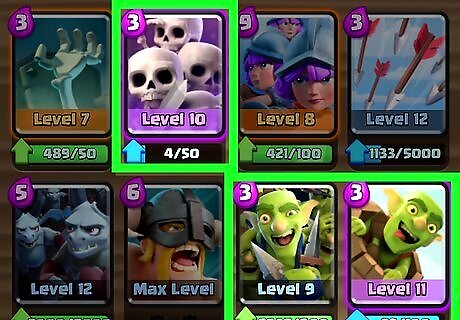
Decide on a deck archetype. Each player makes a deck of 8 cards prior to each battle. The type of deck you create is called your deck archetype. Your deck archetype should complement your win condition and anticipate what your opponent may use to counter it. Each archetype has its own strengths and weaknesses. There are many deck archetypes, but the three main ones are Beatdown, Control, and Siege. Some deck archetypes are as follows: Beatdown: Beatdown decks focus on overpowering your opponent's tower through strength. They have a tanky win condition, such as a Golem, or Giant with high damage troops for backup. These decks start by building up a positive elixir advantage and build a huge push to attack the opponent's tower. Control: Control decks are defensive decks that fight from your side of the map. Control decks have a strong defense, which usually includes buildings, such as Cannon, Tesla, and Inferno Tower. These decks get an elixir advantage from countering huge pushes and chip away at the opponent's tower until it is destroyed. Siege: Siege archetypes are based around a strong offensive building win condition, either Mortar or X-Bow. These buildings attack from your side of the map and force your opponent's units to your side of the map to defend, while you defend your offensive buildings so that they can keep doing damage to your opponent's tower. Mortar is typically combined with a second win condition such as Miner. Hybrid: Hybrid decks combine two archetypes and two win conditions for a deck that can surprise your opponent. A hybrid deck might have Golem and Graveyard for example. Cycle: Cycle decks are very cheap (usually 3.0 or less in average elixir cost. They rely on quickly placing their win condition faster than your opponent can get back to their counter card. These decks chip away at the other towers, doing damage over time. Any amount of damage matters. Spell Bait: Spell bait is a type of hybrid deck The goal is to get your opponent to waste their spells, and then overwhelm them with hordes of troops when they can no longer counter your attack. These decks have many cards vulnerable to spells such as Skeleton Army, Guards, Goblin Gang, and Goblin Barrel. Those are common in log bait decks while Royal Hogs, Flying Machine, Barbarians, Minion Horde, and Three Musketeers are used in medium and heavy spell bait. Bridge spam: Bridge spam is an archetype invented by Team Vietnam. The cards in it are usually combinations of Royal Ghost, Bandit, Dark Prince, Ram Rider, Battle Ram, and other cards. It focuses on punishing other players for investing elixir by rushing them with combos that can take a tower in seconds. Don't play high-cost troops at the back against these decks because there is no way you can defend their rush attack with few elixir. Split lane: With the addition of more cards that can be split (Royal Hogs, Zappies, Royal Recruits, Guards, etc), this archetype has risen to popularity. Both lanes will be taken up by very threatening pushes and your opponent will have to try and defend both sides simultaneously.
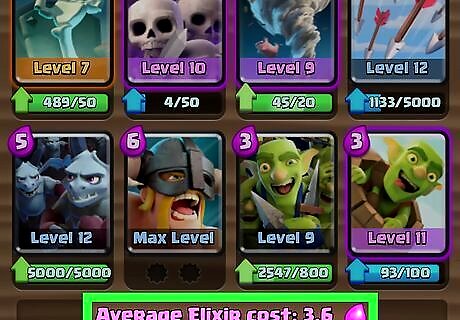
Aim for an average elixir cost. Most good decks are between 3.0-4.0 in average elixir cost (AEC). There are good decks higher or lower than that. Cheaper decks are faster in cycle but have more fragile troops. Heavy decks have a slower playstyle and are usually Beatdown decks. If you have an average elixir cost of 4.0 or above, you might want to consider having the elixir collector in your deck. This card will collect more elixir for you and allow you to play troops faster. However, this is also a high cost card, as it is 6 elixir. Cycle decks go as low as 2.6 for the AEC since the playstyle requires the player to cycle to their win condition quickly.

Think about your playstyle. Do you want a fast deck continually attacking the opponent? Do you want a slow deck that builds up momentum? Or do you want a balance of the two? It is up to you. Troops have different movement speeds. For fast decks, you might want speedy Hog Riders, Elite Barbarians, or Goblins. A slow deck could include the mighty Golem, P.E.K.K.A, or Executioner.

Make sure you will have a counter for everything. Get troops that attack air, do splash damage, deal heavy single-target damage, and troops that do more than one at a time. You will need one of each on your deck to make it effective. Musketeer, Minions, and Mini Pekka are some troops that do single-target damage. Wizard, Witch, and Bowler are examples of splash attackers.
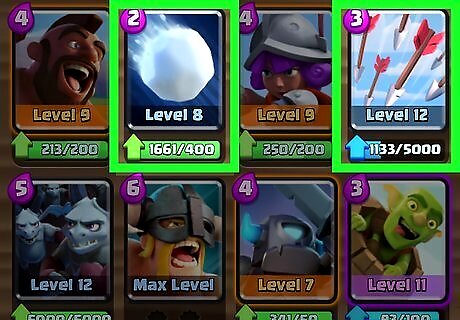
Think about the meta and create a meta counter deck. Meta stands for Most Efficient Tactic Available. These are the commonly used (and powerful) decks in an arena or league. Knowing the meta allows you to craft a deck to counter the most commonly used decks. However, be careful so that your deck is not weak to other non-meta decks that are often used. For example, you may see a lot of people running log bait at your trophy range. To counter this, run two small spells in your deck. You can choose from Tornado, Zap, Arrows, Barbarian Barrel, Giant Snowball, and the Log.
Take card rarities into account. If your deck is full of legendary cards, it can take years to fully max out the cards especially if you do not spend money on the game. Common cards are the easiest to level up. If you want a deck that is easy to level up, include mostly common cards and one each of the other rarities.
Filling the Individual Roles
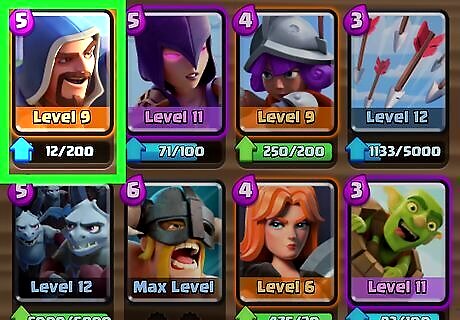
Choose support cards for your win condition. These cards compliment your win-condition and help defeat its counters. You should try to play these with your win condition. They need support to be effective and are usually glass cannons or splash units. For example, Fisherman is good with Royal Giant because it can pull your opponent's defensive cards away from the Royal Giant. Some support cards are Valkyrie, Musketeer, Witch, and Electro Wizard. A lot of win condition supports are in the group sometimes referred to as the "fireballies" which means they survive an equal level fireball with a sliver of health.
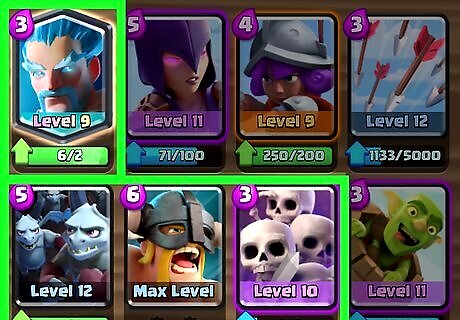
Select defensive cards. These are generally slow-moving cards good for protecting your towers. Some are swarms of low health cards that do a lot of damage. These include Ice Wizard, Barbarians, Minion Horde, and Skeleton Army.
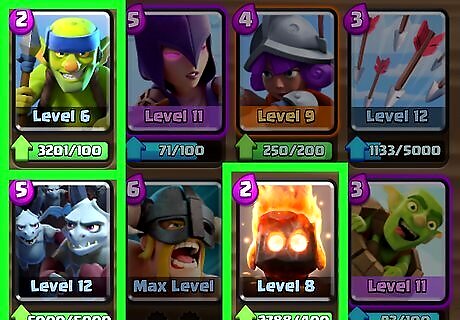
Decide on cycle or utility cards. Cycle cards are cheap and cycle your deck for a better card to use. Utility cards can be used to counter many other card and are usually also cheap. Both of these can help you make positive elixir trades, or when you spend less elixir to counter a troop than it cost for your opponent to deploy it. This allows you to have more elixir than your opponent. Cycle cards include Ice Spirit, Electro Spirit, Fire Spirit, and Skeletons. Some utility cards are Spear Goblins, Minions, and Bats.

Add a building. These will be the main part of your defense, Some buildings spawn troops periodically. Others do damage against enemy troops. Most decks will have one of these in them. The Inferno Tower does damage that increases over time. The Cannon is cheap (3 elixir), so you can use it to kill Hog Riders and defend small pushes. Tesla is like a cannon that targets air. Bomb Tower deals splash damage and has a death bomb, pairing well with Tornado. The Barracks spawns Barbarians, Goblin Hut spawns Spear Goblins, Furnace hatches Fire Spirits, and Tombstone raises Skeletons. Mortar and X-Bow are win conditions in siege decks, but they are also used on defense since they can shoot at units from a long distance.
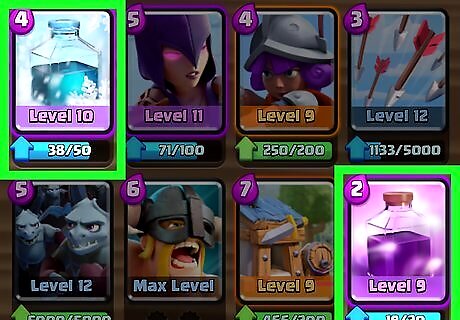
Put at least one spell in your deck. These offer direct damage and are incredibly useful when finishing towers. They all have different effects and costs. Most decks have two spells, one big spell and one small spell. Big spells include Fireball, Rocket, Lightning, and Poison. Small spells include The Log, Zap, Barbarian Barrel, and Giant Snowball. Some spells affect troops. Heal spell heals your troops. Rage increases movement speed and attack speed. Freeze stops troops in place. Clone makes copies of your troops that have only one hit-point.
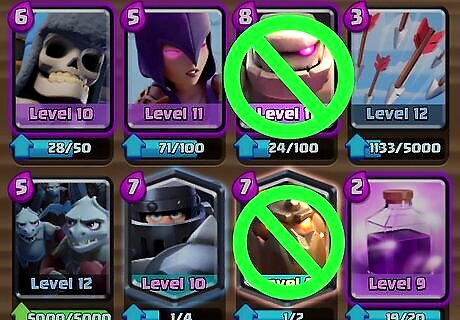
Avoid having four or more dead cards. These are cards that you don't want to play as the first move or cycle in the back. If you end up with four of them in your hand at one time, you won't have a good card to play and will be forced to leak elixir or make a risky move. For example, you wouldn't want to cycle Inferno Dragon in the back to start out, or your opponent could play a lava hound in the opposite lane and you would have no good counter. A Golem, any heavy spell, and most buildings are dead cards since playing them leaves you open to an attack. Three elixir cards or less such as Ice Spirit, Archers, and Goblins are good to include in your deck since you can play them without a large fear of not having a response to your opponent's cards.
Think about synergies. You want your deck to have good synergy, meaning the cards work well with each other. For example, you always run Executioner with Tornado to line troops up for his axe to hit all of them.













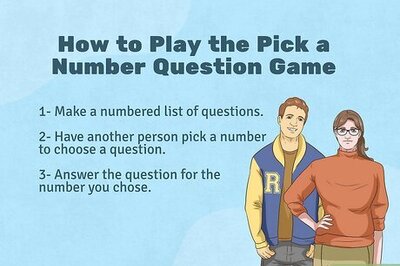

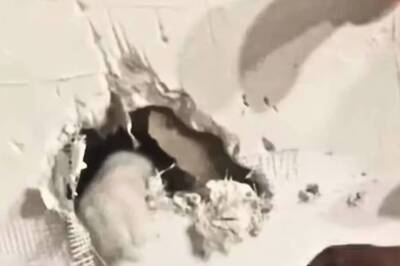

Comments
0 comment